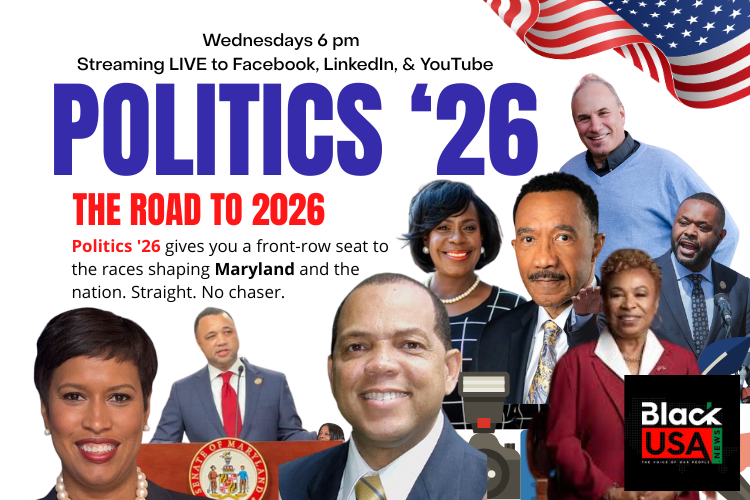BlackUSA.News’ POLITICS ’26, Wednesdays at 6pm
Streaming LIVE on Facebook, LinkedIn, and YouTube
(RANDALLSTOWN – July 31, 2025) – Now that Johnny Olszewski is a Congressman, Baltimore County braces for what may be one of the most consequential County Executive elections in recent memory. The June 2026 Democratic Primary is shaping up to be even more competitive than 2018, when Olszewski eked out a 17-vote win over political heavyweights Sen. Jim Brochin and Councilwoman Vicki Almond. I was there for the recount, watching as the results came back exactly the same. Unbelievable. Especially coming off the 2016 Baltimore City mayoral race, where 1,800 voting irregularities were reported—compared to just 200 across the other 23 jurisdictions in Maryland. Trust me, I know elections. And Baltimore County, while different in tone and tempo, is no less political.
Baltimore County’s demographic and political terrain is distinct. While Baltimore City is roughly 60% Black, the County is about 30% Black. Yet, don’t underestimate the economic and political influence of those 250,000+ Black residents—especially in Randallstown and Owings Mills. While exact data on their contribution to the County’s tax base isn’t published, one can safely assume it’s substantial. Black political power in the County began along the Liberty Road corridor. Pioneers like Ella White Campbell, Sen. Delores Kelley, Speaker Adrienne Jones, and Ken Oliver built the infrastructure for what is now a formidable political base. Delegate Cheryl Pasteur and strategist Kenny Brown continue to carry that torch today – along with Senator Ben Brooks and Senator Charles Sydnor. Simply put: few win countywide office without strong support from the Westside.
So far, Councilman Pat Young (District 1) and attorney Nick Stewart have expressed interest but, according to the state’s website, have not officially declared their candidacy. But political insiders are watching two other key players, neither of whom has announced: Councilmen Julian Jones (District 4) and Izzy Patoka (District 2). Julian is Black. Izzy is Jewish. Both are seasoned and smart, and both are eyeing each other’s territory. Their districts are adjacent, and the Liberty Road corridor runs through them both. That means Liberty Road voters will be pivotal in 2026. Who will win Liberty Road? Community leaders should be organizing now, interviewing both men, and demanding commitments for the projects that matter most to their constituents. Any leader worth their salt already has both candidates’ cell numbers saved.
Simultaneously, the wildcard is the Eastside. While Jones has roots in East Baltimore, the Eastside of the County remains largely white—and for Patoka, that means reaching beyond his Jewish base. Both candidates need a broader, countywide message to win. This won’t be decided by identity politics alone. I suspect that this race will cause one person to rise above the crowd. That person will have studied, prepared, and engaged the electorate better than the rest of the field. Who has the ability to galvanize the largest number of voters? Who has the heart, the nerve, that je ne sais quois, that gravitas necessary to be the winner? And who will the people gravitate to?
Beyond personalities and alliances, the issues shaping this race are clear. A UMBC poll showed voters prioritize reproductive rights, inflation, and trust in government. Public safety is top-of-mind, especially after the county recorded a record 54 homicides in 2023. Olszewski increased the police budget and launched mental health diversion programs, but critics argue the reforms have weakened enforcement.
Voters also approved major charter amendments: expanding the County Council from seven to nine members to improve representation and shield the Inspector General’s office from political interference. It should be noted that Linda Walker-Dorsey and her efforts have pushed for 11 members—not 9. Meanwhile, the County has committed to $578 million in capital investments for schools, roads, and public facilities. These investments may require future tax increases or cuts.
Another twist? The 2026 election will be the first under the County’s new Fair Election Fund—a public campaign finance program designed to level the playing field. Candidates will be limited in how much they can raise, with small-dollar donors taking on a more prominent role.
All of this means Baltimore County’s 2026 Executive race isn’t just about who sits in the top seat—it’s a referendum on representation, public safety, and who gets heard in the next generation of county governance. And Liberty Road? It’s not just a corridor—it’s a kingmaker.

